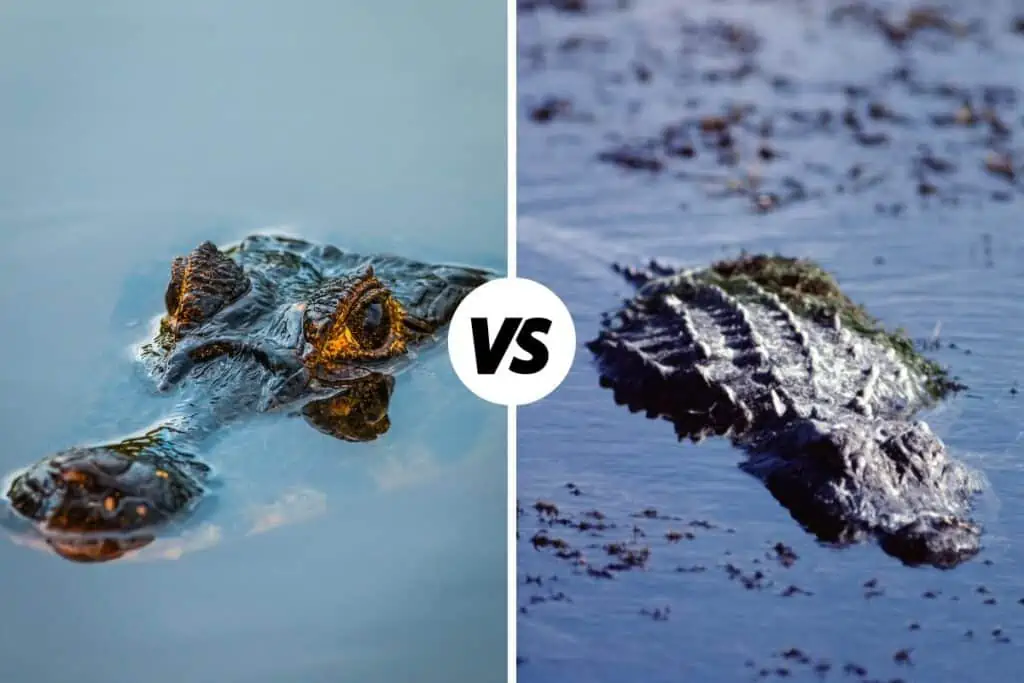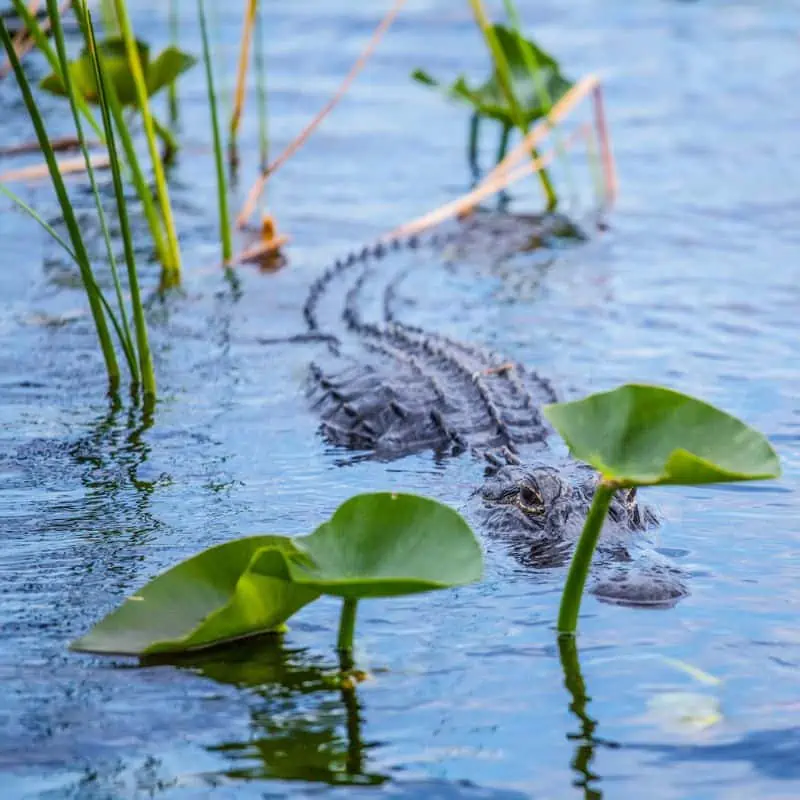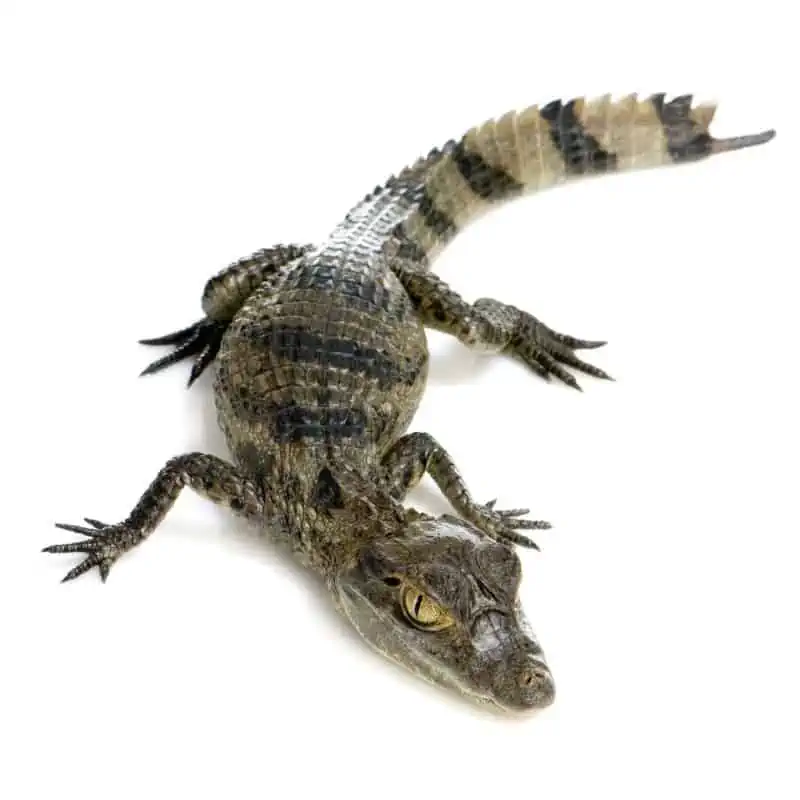The caiman and alligator are two apex predators mostly found in the Americas, but how much do we know about the caiman vs alligator, and what’s the difference?
Caimans and alligators are closely related members of the Crocodilia order and share many similarities. The best way to differentiate them is that alligators are endemic to North America, while caimans are distributed through Central and South America. Their size, teeth, and scales also vary.
Although caimans and alligators are closely related, they are not identical. Below we’ll examine their differences and similarities in physical characteristics, distribution, habitat, behavioral traits, and conservation.

Caiman Vs Alligator: Summary Of Differences
How could you tell a caiman from an alligator? Although these crocodilians look similar and are closely related (closer than alligators or caimans and crocodiles), there are some subtle (and obvious) differences between these large toothy reptiles.
These differences include:
- Distribution. Alligators and Caimans occur in different areas and occupy different habitats. Alligators’ natural distribution is in North America and China. Caimans inhabit Central and South America.
- Alligators are generally larger than (most) caimans (particularly those in the Americas, who might be confused).
- Caimans generally have rougher scales on their bellies and backs and more on their heads.
- Although we don’t recommend getting close enough to inspect it, alligators have “rounded” teeth.
Taxonomic Differences
Although taxonomy may seem irrelevant at first glance, understanding the information in the table below (and taxonomic information in general) helps scientists understand where different animal species separated from a common ancestor.
| Caiman | Alligator | |
| Kingdom | Animalia | Animalia |
| Phylum | Chordata | Chordata |
| Class | Reptilia | Reptilia |
| Order | Crocodilia | Crocodilia |
| Family | Alligatoridae | Alligatoridae |
| Subfamily | Caimaninae | Alligatorinae |
| Genus | Caiman, Melanosuchus, and Paleosuchus | Alligator |
| Species | C. crocodilus (Common/Spectacled caiman) | A. mississippiensis (American alligator) |
| C. latirostris (Broad-snouted caiman) | A. sinensis (Chinese alligator) | |
| C. yacare (Yacare caiman) | ||
| M. niger (Black caiman) | ||
| P. palpebrosus (Dwarf/Cuvier’s Smooth-fronted caiman) | ||
| P. trigonatus (Schneider’s Smooth-fronted caiman) |
Caimans and alligators are closely related. Caimans are a type of alligator, and they share taxonomical classification until the family level. However, caimans split into a separate subfamily Caimaninae, which contains six species in three genera.
There are only two alligator species under one genus. Alligators belong to the Alligatorinae subfamily.
Some sources do not include subfamilies and, following families, list caimans, and alligators under their respective genera.
Distribution And Habitat Difference
The most significant difference between caimans and alligators is in their distribution.
This geographical divide between caimans and alligators is because, while alligators are temperate species adapted for cooler temperatures, caimans are a tropical group of crocodiles, and they can’t survive in cooler regions (like the USA north of Florida).
Alligator Distribution And Habitat
The American alligator is endemic to North America, and its range stretches across the south eastern USA, from Florida to North Carolina and westwards to eastern Texas.
The Chinese Alligator is the only member of the alligator family (including caimans) found outside the Americas.
Although Chinese alligators once occupied an extensive range along the Yangtze River system of Eastern China, their current distribution is limited to the Anhui province and parts of the Jiangsu and Zhejiang provinces, covering an area of roughly 167 square miles.
Within their ranges, alligators occupy various lowland freshwater areas, including:
- Lakes
- Marshes
- Slow-moving rivers
- Swamps
- Wetlands
- Man-made canals, reservoirs, and dams
Although alligators can use salt water, they don’t spend extended periods in these water bodies as they lack the tongue glands crocodiles have to remove excess salt from their bodies.

Caiman Distribution And Habitat
All six caimans are endemic to Central and South America. Their distributions include:
| Caiman species | Region of the Americas | Range |
| Spectacled caiman | Central and South America | Mexico, Brazil, Colombia, Costa Rica, Ecuador, El Salvador, French Guiana, Guyana, Guatemala, Honduras, Nicaragua, Panama, Peru, Suriname, Trinidad and Tobago, and Venezuela. |
| Broad-snouted caiman | South America | Argentina, Bolivia, Brazil, Paraguay, and Uruguay. |
| Yacare caiman | South America | Argentina, Bolivia, Brazil, and Paraguay. |
| Black caiman | South America | Bolivia, Brazil, Colombia, Ecuador, French Guiana,Guyana, and Peru. |
| Dwarf/Cuvier’s Smooth-fronted caiman | South America | Bolivia, Brazil, Colombia, Ecuador, French Guiana,Guyana, Paraguay, Peru, Suriname, and Venezuela. |
| Schneider’s Smooth-fronted caiman | South America | Bolivia, Brazil, Colombia, Ecuador, French Guiana,Guyana, Peru, Suriname, and Venezuela. |
The Speckled caiman has the most extensive range, and there are some introduced populations in Cuba, Puerto Rico, and the United States.
Within this range, caimans frequent freshwater water bodies, including:
- Lakes
- Mangrove swamps
- Slow-moving rivers
- Swamps
- Water Bodies in the Amazon and other rainforests
- Man-made structures like canals
Although speckled caimans are widespread and occur in brackish waters, caimans also lack the salt-removing gland and prefer freshwater.

Physical Characteristics And Differences
Although caimans and alligators look similar (both species are a darker color, often olive), there are certain distinguishing physical features, including:
- Alligators are usually larger than most caiman species. American alligators grow between 8 and 12 feet (some individuals reach 13 feet) and weigh up to 1 000 pounds. Chinese alligators are much smaller at roughly 5 feet and weigh 50 to 85 pounds.
- The Black caiman is the largest species and reaches lengths of 13 to 15 feet (some sources claim that they reach lengths of 20 feet). They weigh up to 880 pounds but are usually lighter. The smallest caiman is the Cuvier’s dwarf caiman at roughly 5 feet and around 15 pounds.
- The shape of the jaw differs slightly between caimans and alligators. Caimans have a large top jaw, and their teeth are usually “pointier,” and the inside of their mouth is an orange color. Alligators have round/conical teeth and a small overbite. Their mouths are a beige color.
- Caimans tend to have larger eyes, which are higher on their heads.
- Caimans possess composite osteoderms, giving them rougher-looking skin, while alligators have singular osteoderms.

Behavioral Traits And Differences
Caimans and crocodiles are opportunistic feeders that follow a carnivorous lifestyle. Although they are not usually “picky” eaters, some diet variations exist.
Alligators eat turtles, fish, deer, birds, rodents, muskrats, and snakes. Caimans eat various birds, mammals (including capybaras, rodents, and deer), mollusks, fish, snails, and snakes.
If caimans and alligators can overpower an animal, they’ll eat it.
Both species are ambush predators, waiting to dart out of the water, lock their powerful jaws on their prey, then drag it underwater to drown it. Caimans are usually more aggressive than alligators, however.
Alligators and caimans usually breed once a year. Alligators and some caiman species construct nest mounds with vegetation on riverbanks. Some caiman species burrow.
The Cuvier’s Dwarf caiman often digs burrows to rest in during the heat of the day.
Conservation And Threats
Although these are apex predators, caiman and alligator populations suffer due to humans causing habitat destruction, poaching, pollution, and hunting/shooting “problem” animals.
The Chinese alligator is critically endangered on the IUCN Red List.
Most caimans are least-concern. However, caiman populations will decline without interventions like CITES or National Parks protecting their natural habitat.
Final Thoughts On Alligator And Caiman Differences
Caimans and alligators are part of the same family and are closely related.
While there are some physical differences, the most significant difference between the species is their distribution.
Of all the species in this family, only the Chinese alligator is critically endangered; however, all species are threatened by habitat destruction from human expansion.
